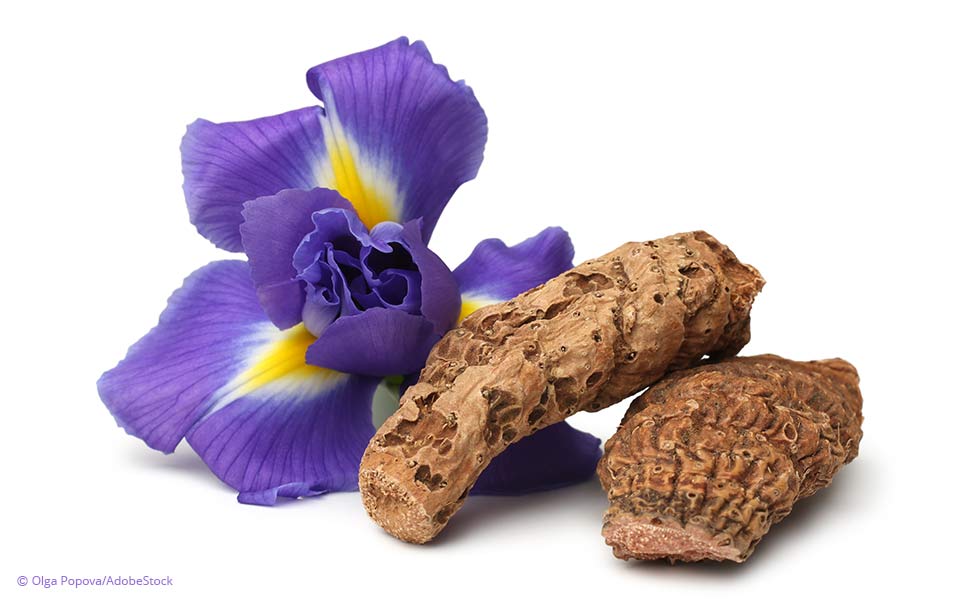The most expensive ingredients in 21st century perfumery
Yet a once cheap substitute for the priceless violet extract continues to defy the ingenuity of fragrance chemists and has in consequence become one of the most expensive ingredients in 21st century perfumery: Orris root oil, which is prepared from the dried rhizomes of the Dalmatian or Florentine iris (Iris pallida) and can cost up to $75,000 per kilogram.
Notoriously difficult to synthesize
Orris root oil is a mixture of five different closely related terpene derivatives, (+)-cis-𝛼-irone, (−)-trans-𝛼-irone, (+)-𝛽-irone, (+)-cis-𝛾-irone, and (+)-trans-𝛾-irone that share the same basic carbon skeleton but differ in their stereochemistry and in the placement of a single double bond. They are notoriously difficult to synthesize and can usually only be obtained as racemic mixtures, i. e. impure preparations that contain both members of a pair of stereoisomers. Due to the difficulty in obtaining pure orris oil ingredients, fragrance chemists have not yet been able to reconstitute this unique scent from its individual chemical components, nor from less costly ingredients, as has been possible with almost all other floral fragrances.
Orris root – the “secret ingredient”
To this day, orris root remains a sought-after “secret ingredient” for perfumers, the scent of which is dependent on the particular harvest year of the iris flowers from which it was obtained. It comes as no surprise then that orris oil is used in some of the most expensive creations by the luxury perfume brands Chanel, Hermès, Guerlain, Dior, Calvin Klein, and others.
From: Scent and Chemistry: The Molecular World of Odors, 2nd Edition, Günther Ohloff, Wilhelm Pickenhagen, Philip Kraft, Fanny Grau, ISBN: 978-3-527-82998-9

Science makes Sense! Die Sinne des Menschen und die Entwicklung der modernen Naturwissenschaften
Die Sinne des Menschen – das Riechen, Schmecken, Sehen, Fühlen und Hören – haben eine fundamentale Rolle bei der Entwicklung der modernen Naturwissenschaften gespielt. Sie waren nicht nur die Antriebskraft für die Neugier der frühen Forschenden seit der Antike,...

Der Einfluss der Wissenschaft auf unser Weltbild
Wie wir Menschen unsere Welt begreifen, hat historisch betrachtet sehr viel mit unseren unmittelbaren Sinneserfahrungen zu tun sowie mit unserer Erwartung, dass unsere Welt eine geordnete ist. Biblische und andere Schöpfungsmythen haben versucht, die Sinneserfahrung...

Die Physik des Hörens
Das menschliche Gehör ist ein erstaunlich komplexes System, das uns ermöglicht, eine breite Palette von Klängen wahrzunehmen – von den tiefen Tönen eines Basses bis hin zu den hohen Tönen einer Violine. Das Hören funktioniert in zwei Hauptschritten: Zuerst wandelt das...
Warum fühlt sich kalte Wäsche nass an?
Mit Sicherheit kennst du das Phänomen - deine kalte Wäsche fühlt sich feucht an, obwohl sie objektiv nicht nass ist. Grund dafür sind unsere Sinne und wie sie funktionieren und dadurch Feuchtigkeit wahrnehmen. Die Rolle der Temperatur und Haptik Unsere Haut ist ein...


